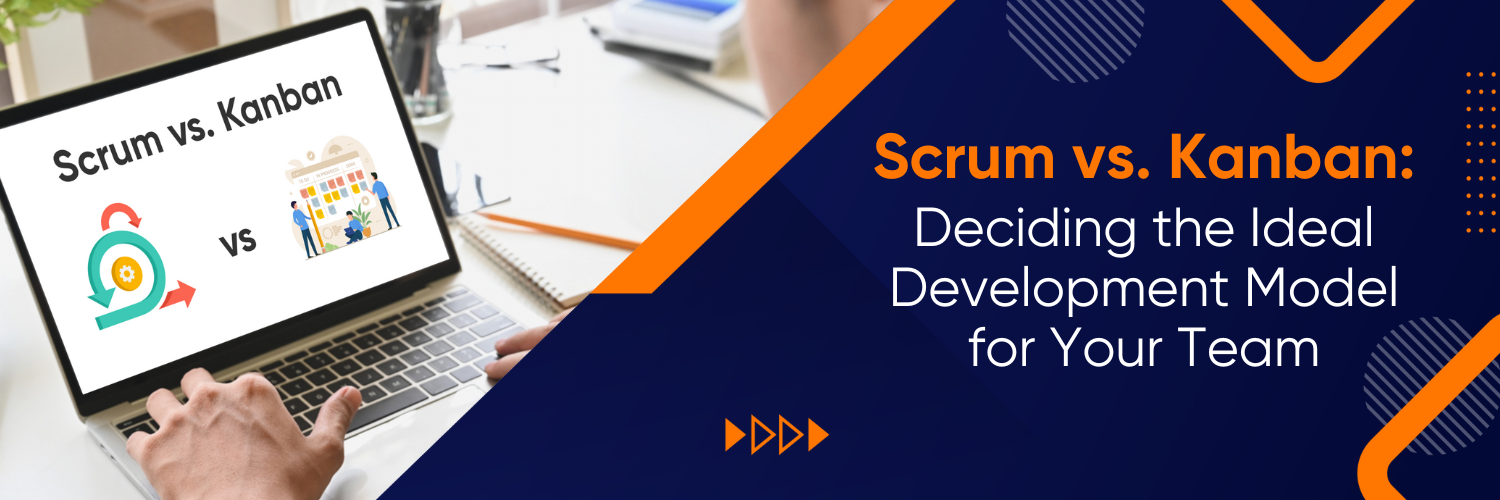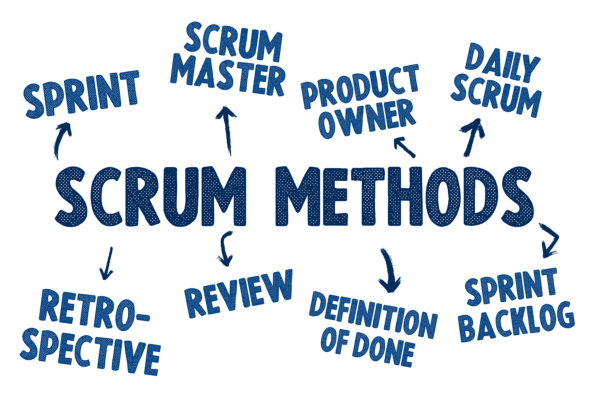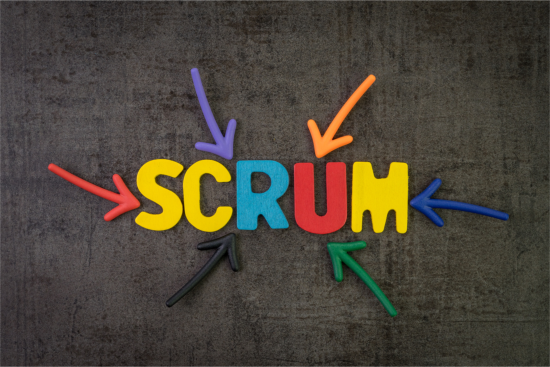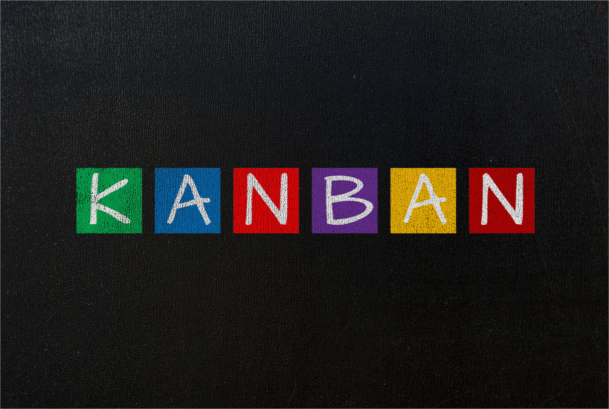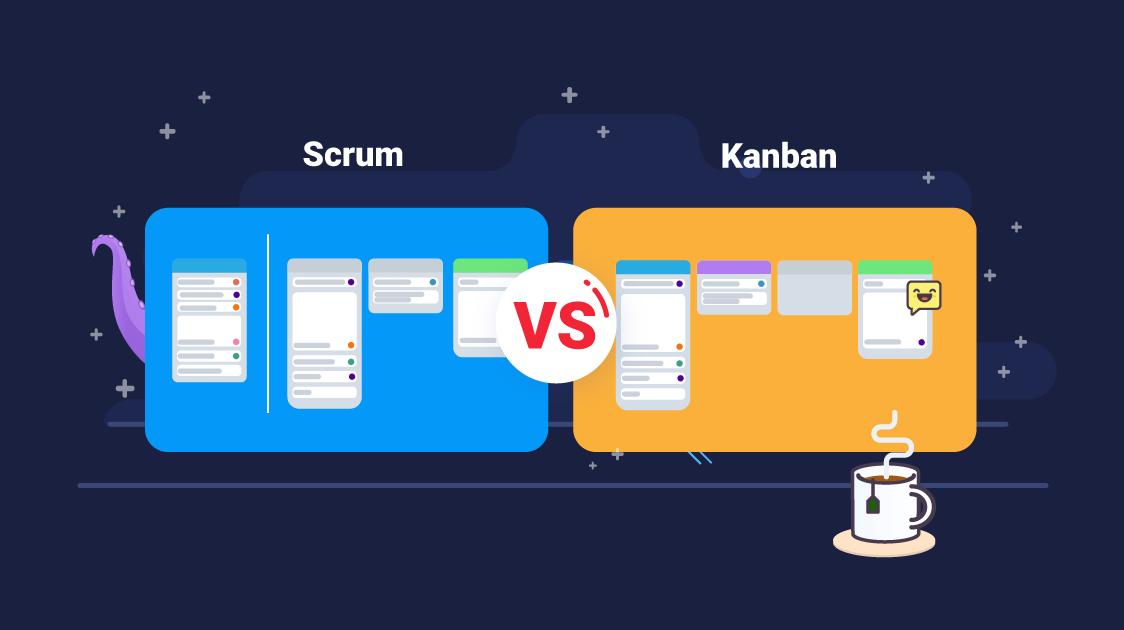Agile Project Management
In today’s fast-paced world of software development, Agile methodologies have become essential for staying competitive and delivering high-quality products. Among these methodologies, Scrum and Kanban stand out as popular choices, each offering unique approaches to managing projects and teams. Choosing the right development model is crucial for maximizing efficiency and productivity. This blog aims to provide an in-depth comparison between Scrum and Kanban, helping you make an informed decision based on your team’s needs and project requirements.
What is Scrum?
Scrum is a well-defined framework within the Agile spectrum, designed to promote collaboration, adaptability, and iterative progress. At its core, Scrum involves three key roles: the Product Owner, responsible for defining and prioritizing the backlog; the Scrum Master, ensuring the team adheres to Scrum principles and practices; and the Development Team, responsible for delivering increments of work during each sprint. Scrum ceremonies, including Sprint Planning, Daily Standup, Sprint Review, and Sprint Retrospective, provide structure and continuous improvement opportunities.
The framework utilizes artifacts like the Product Backlog, a dynamic list of features and tasks; the Sprint Backlog, detailing work for the current sprint; and the Increment, the tangible output of each sprint. While Scrum enhances team collaboration and accountability, its time-boxed approach may sometimes introduce rigidity and challenges in handling rapidly changing priorities.
What is Kanban?
Kanban, on the other hand, focuses on visualizing the workflow, limiting work in progress, and fostering continuous improvement. The methodology revolves around principles such as visualizing the workflow, identifying work item types and classes of service, setting Work in Progress (WIP) limits, and driving evolutionary change. Kanban boards provide a visual representation of tasks, categorized into columns like Backlog, To-Do, In Progress, and Done.
By maintaining WIP limits, Kanban ensures a steady and controlled flow of work, reducing bottlenecks and enhancing efficiency. Continuous improvement is a fundamental aspect of Kanban, encouraging teams to analyze their processes regularly and make incremental adjustments. While Kanban promotes flexibility and adaptability, it may lack the structured framework that Scrum provides, potentially leading to less predictability in project timelines.
Scrum vs. Kanban: Comparison
Comparing Scrum and Kanban reveals distinct differences in their approaches. Scrum offers a well-defined structure with time-boxed sprints, fostering adaptability within those set intervals.
Aspect | Scrum | Kanban |
| Approach | Time-boxed sprints with defined roles and ceremonies | Continuous flow with visualized workflow |
| Flexibility and Adaptability | Moderate flexibility within sprint boundaries | High adaptability, accommodating changing priorities |
| Predictability and Planning | Predictable with fixed sprint scope and duration | Less predictable, adapts to changing requirements |
| Team Collaboration | Emphasis on regular communication (ceremonies) | The visual board promotes transparency and collaboration |
| Changing Priorities | Handled through backlog refinement and sprint planning | Dynamic reordering based on business needs |
| Ideal Project Types | Complex projects with evolving requirements | Stable projects with a focus on incremental improvements |
| Strengths | Structured framework, planning, and accountability | Flexibility, adaptability, and continuous improvement |
| Challenges | Potential rigidity, may not suit rapidly changing priorities | Less structured, potential for reduced predictability |
| Team Size | Well-suited for medium to large teams | Adaptable for both small and large teams |
This table provides a concise overview of the key differences and strengths of Scrum and Kanban, helping you make an informed decision about which methodology aligns best with your team’s needs and project requirements.
Scrum vs. Kanban: Benefits
Scrum and Kanban are two popular Agile methodologies used in software development and project management, each with its own set of benefits. Here are some of the advantages of using Scrum and Kanban:
Benefits of Scrum:
- Structured Framework: Scrum provides a well-defined framework with roles (Product Owner, Scrum Master, and Development Team), ceremonies (Sprint Planning, Daily Standup, Sprint Review, and Sprint Retrospective), and artifacts (Product Backlog, Sprint Backlog, and Increment). This structure helps teams stay organized and focused on their goals.
- Predictable Delivery: Scrum uses fixed time periods called Sprints, typically 2-4 weeks, during which the team works on a set of prioritized backlog items. This predictability helps in planning and managing stakeholder expectations.
- Increased Collaboration: Daily Standup meetings and regular Sprint ceremonies facilitate communication and collaboration within the team, leading to a better understanding of progress and potential roadblocks.
- Customer Focus: Scrum emphasizes the importance of delivering value to the customer. The Product Owner represents the customer’s interests and maintains a prioritized backlog to ensure the team works on the most valuable features.
- Continuous Improvement: Sprint Retrospectives encourage the team to reflect on their processes and make improvements. This iterative feedback loop can lead to a more efficient and effective development process over time.
Benefits of Kanban:
- Flexibility: Kanban is highly adaptable and doesn’t prescribe fixed time frames like Scrum. Work flows continuously based on demand and capacity, making it suitable for both long-term projects and ongoing maintenance tasks.
- Visual Management: Kanban boards provide a visual representation of work items and their status, allowing teams to quickly understand the workflow and identify bottlenecks or inefficiencies.
- Reduced Waste: Kanban focuses on limiting work in progress (WIP) and optimizing the flow of work. This can lead to reduced waste, shorter lead times, and improved overall efficiency.
- Quick Response to Changes: Kanban encourages teams to be responsive to changing priorities and requirements, as work items can be added or reprioritized at any time without disrupting a fixed Sprint cycle.
- Improved Team Autonomy: Teams have more autonomy in managing their workload and can make decisions based on real-time data from the Kanban board, which can lead to increased motivation and ownership.
- Continuous Delivery: Kanban promotes a continuous delivery approach, where work items are delivered to customers or stakeholders as soon as they are completed, rather than waiting for the end of a Sprint.
Choosing the Right Fit for Your Team
Selecting the appropriate development methodology, whether Scrum or Kanban, requires a thoughtful evaluation of your team’s dynamics, project requirements, and organizational goals. Here’s a guide to help you make an informed decision:
Assess Your Team’s Needs and Preferences
- Engage with your team members to understand their skill sets, working styles, and preferences.
- Identify the strengths and weaknesses of your team members in terms of collaboration, adaptability, and time management.
Analyze Project Requirements and Characteristics
- Examine the nature of your project – is it complex and likely to evolve, or is it stable with relatively predictable workflows?
- Consider the level of interaction required with stakeholders and customers. Are frequent feedback loops necessary?
Evaluate Team Size and Composition
- Larger teams may find Scrum’s structured roles and ceremonies beneficial for clear communication and accountability.
- Smaller teams might appreciate Kanban’s flexibility and adaptability, allowing them to manage work without the constraints of sprints.
Review Existing Processes and Workflows
- Evaluate your current development processes. Do they align more closely with Scrum’s time-boxed iterations or Kanban’s continuous flow?
- Consider any existing tools or practices that might integrate well with one methodology over the other.
Consider Hybrid Approaches
- Explore the possibility of combining elements from both Scrum and Kanban to create a custom approach that suits your team’s unique needs.
- For example, you could use Scrum for project planning and Kanban for ongoing maintenance tasks.
Gather Input from Stakeholders
Involve stakeholders and customers in the decision-making process. Their input can provide valuable insights into the preferred methodology based on their expectations and requirements.
Pilot and Iterate
- If you’re uncertain about the best fit, consider running a pilot project with a small team to test either Scrum or Kanban.
- Gather feedback and insights from the pilot to refine your chosen approach before implementing it across the entire team.
Training and Skill Development
Ensure that your team members receive proper training and education in the selected methodology. This ensures everyone is on the same page and understands their roles and responsibilities.
Alignment with Organizational Goals
Evaluate how well each methodology aligns with your organization’s long-term goals and strategies. Consider factors such as speed to market, customer satisfaction, and innovation.
Regular Review and Adaptation
- After implementing the chosen methodology, regularly review its effectiveness. Are you achieving the desired outcomes? Is the team’s performance improving?
- Be open to making adjustments and refinements as needed to optimize your chosen methodology for your team’s success.
Ready to Streamline Your Projects? Click to Get Started.
Implementation and Best Practices
Transitioning to a new development methodology requires careful planning and execution. Whether you’re adopting Scrum or Kanban, following best practices will help ensure a successful and smooth transition, leading to improved team productivity and project outcomes.
Implementing Scrum
Education and Training
Provide comprehensive training to your team members about Scrum principles, roles, ceremonies, and artifacts. This will help everyone understand their responsibilities and how the framework operates.
Scrum Team Setup
Identify and assign roles within the Scrum team: Product Owner, Scrum Master, and Development Team. Clearly define their responsibilities and create a collaborative environment.
Backlog Refinement
Regularly review and refine the Product Backlog to ensure it’s well-prioritized, detailed, and aligned with project goals. Involve the entire Scrum team in these sessions.
Sprint Planning
Conduct thorough Sprint Planning meetings to define the work that will be completed during the upcoming sprint. Ensure that the Development Team commits to a feasible amount of work.
Daily Standup Meetings
Hold daily standup meetings to facilitate communication among team members. Each member shares their progress, plans, and any challenges they’re facing.
Sprint Review
At the end of each sprint, conduct a Sprint Review to showcase the completed work to stakeholders and gather feedback. Use this feedback to improve future sprints.
Sprint Retrospective
Hold a Sprint Retrospective to reflect on the recently completed sprint. Discuss what went well, and what could be improved, and make actionable changes for the next sprint.
Iterative Improvement
Continuously refine and adapt your Scrum processes based on feedback and retrospective findings. Strive for continuous improvement to optimize team performance.
Implementing Kanban
Visualizing Workflow
Start by mapping out your workflow stages on a Kanban board. This visual representation helps everyone understand the steps from task creation to completion.
Work Item Types and Classes of Service
Define different types of work items and their priority levels. Assign classes of service to tasks to indicate their urgency and handling.
Work in Progress (WIP) Limits
Set WIP limits for each workflow stage. These limits prevent overloading the team and ensure a steady flow of work.
Continuous Improvement
Regularly review the Kanban board and identify bottlenecks or inefficiencies. Encourage the team to suggest improvements and experiment with changes to the process.
Managing Changing Priorities
As new tasks come in or priorities shift, adjust the order of tasks on the board. This flexibility allows the team to adapt quickly.
Measuring Lead Time and Cycle Time
Measure lead time (time taken from task creation to completion) and cycle time (time taken for a task to move through the workflow). These metrics help identify areas for improvement.
Regular Standup Meetings
Hold regular standup meetings to discuss progress, identify potential issues, and ensure alignment within the team.
Conclusion
In the Scrum vs. Kanban debate, there’s no one-size-fits-all answer. Your choice depends on your team’s dynamics, project requirements, and the level of structure you need. The key takeaway is to align your chosen methodology with your team’s goals and continuously strive for improvement. Experiment, adapt, and refine your approach over time. Remember, the ultimate goal is to empower your team to deliver exceptional results while fostering a culture of collaboration and growth.
As you embark on this journey of agile methodology selection and refinement, remember that success often thrives in partnership. To truly amplify your business endeavours, consider partnering with Ubique Digital Solutions. Our expertise in crafting tailor-made solutions and driving businesses to new heights could be the catalyst your team needs. Together, we can shape a roadmap to success that’s not just sustainable but thriving. Discover the power of collaboration – reach out to us today.
FAQs
Q: How do Scrum and Kanban handle changing requirements?
Scrum addresses changing requirements through backlog refinement and sprint planning, ensuring adjustments are made within fixed time-boxed iterations.
Q: Can Scrum and Kanban be combined?
Yes, Scrum and Kanban can be combined in a hybrid approach, often referred to as “Scrumban.” This blend allows you to benefit from Scrum’s structure while leveraging Kanban’s flexibility.
Q: What are the key challenges in transitioning to Scrum or Kanban?
Transitioning to Scrum might involve adapting to fixed sprint cycles and embracing new roles and ceremonies. While transitioning to Kanban could challenge teams to maintain WIP limits, visualize workflows effectively, and promote continuous improvement.
Q: How do you measure the success of Scrum and Kanban implementations?
For Scrum, success can be measured through factors like increased velocity, on-time delivery of sprint goals, and improved team collaboration.
